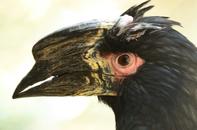
Name
Trumpeter Hornbill - Bycanistes bucinator
Trumpeter Hornbill Appearance
The trumpeter hornbill is a medium sized bird, at 58 cm in length. This hornbill has an all black back and a white belly and underwing coverts. The trumpeter hornbill has red or pink facial skin, with dark coloured eyes and a large grey beak.
This hornbill is distinguished from other hornbills by its colouring and its large grey casque.
Trumpeter Hornbill Diet
The trumpeter hornbill is an omnivore, that feeds mostly on fruit, but will feed on insects, birds eggs and nestlings, wasp eggs and nests. This hornbill is partial to wild figs.
The trumpeter hornbill will readily feed on commercial fruit crops like pawpaw, litchi and guava and nuts.
Trumpeter Hornbill Breeding
The trumpeter hornbill nests in natural tree cavities or small rock caves. The female will seal herself inside the cavity, using mud supplied by the male. To facilitate feeding, she will leave a small hole so the male can feed her and the chicks. At the start of the nesting, the female will moult her tail and flight feathers.
The female will incubate her two to four eggs for around 25 days and will remain in the nest with the chicks for around an additional 50 days after hatching. She will break out of the nest at this point and after around 7 days the chicks will start foraging with their parents.
The complete time that the nest is sealed, the male feeds both the female and the chicks.
Trumpeter Hornbill Behaviour
The trumpeter hornbill is found either singularly or in pairs during the breeding season. Outside of the breeding season, they form large flocks and will use communal roosts. The trumpeter hornbill will fly long distances to forage during the dry season. This hornbill is an important seed disperser in the forest.
Trumpeter Hornbill Call
The trumpeter hornbill makes a loud wailing, nasal call like a crying baby, nhaa, nhaa, ha,ha,ha ……
Threats
None.
Trumpeter Hornbill Distribution and Habitat
The trumpeter hornbill is found in warm evergreen forests, coastal forests with abundant fruit availability. This hornbill can be found from Port Elizabeth northwards, along a narrow coastal belt, up into Mpumalanga and Limpopo.
By Karl Svendsen